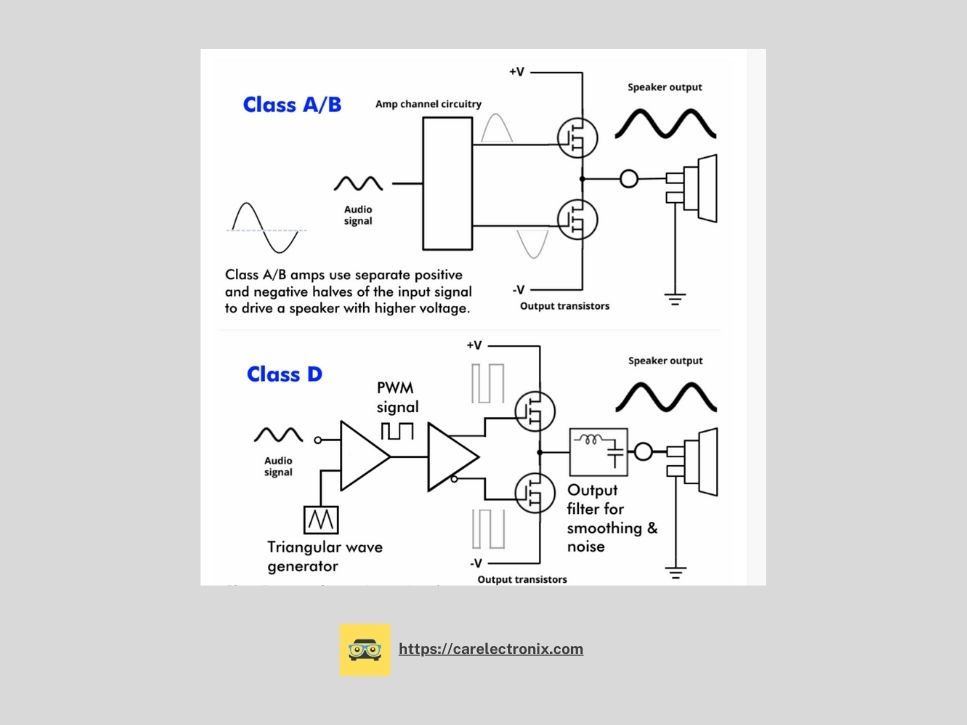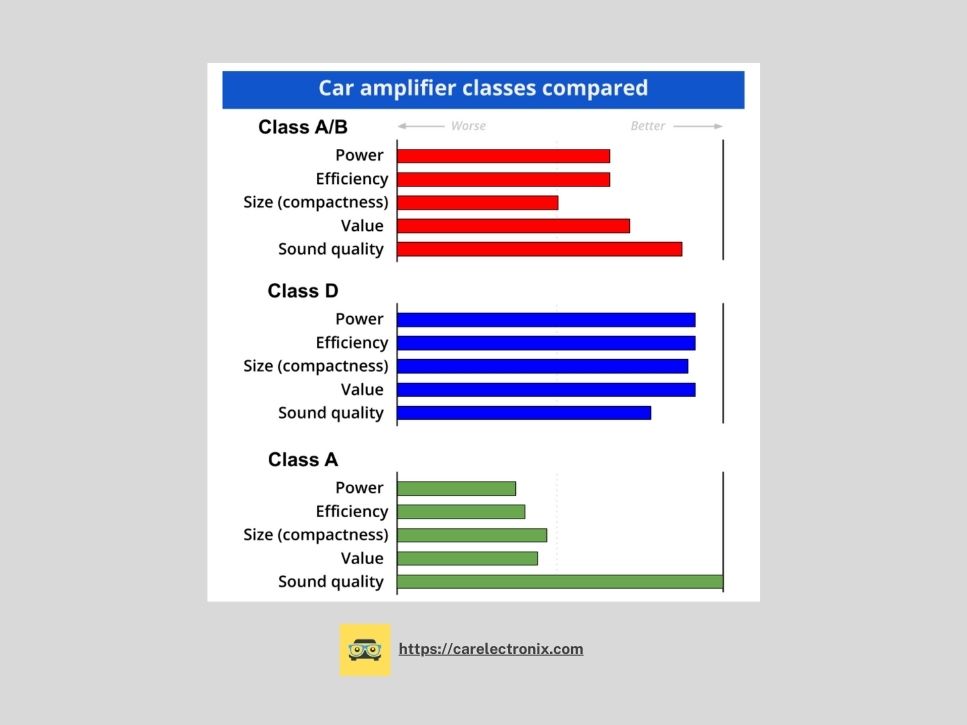
The amplifier classes are denoted by one or two letters on the specification sheet for amplifiers, like A, AB, D, H, etc. In the consumer home audio industry, Class D and Class AB are the two most common ones. This article provides details about the differences between them that will help you determine which ones are most important to you.
At a glance. Class AB vs. Class D Amplifiers
| Class AB Amplifiers | Class D Amplifiers | |
|---|---|---|
| Efficiency | Moderate | High |
| Power Dissipation | High | Low |
| Size | Larger | Smaller |
| Heat Generation | Significant | Minimal |
| Sound Quality | Good | Good to Excellent |
| Power Output | Lower | Higher |
| Price | Moderate to High | Moderate to Low |
| Power Efficiency | Lower | Higher |
| Applications | High-fidelity audio, professional audio systems | Car audio, home audio, portable audio |
On the other hand, class D amplifiers are more efficient than class AB amplifiers, but have lower fidelity (how accurately a copy reproduces its source) than class AB amplifiers.
How Are Class AB and D Amplifiers Used?

With incredibly low distortion, class AB amplifiers deliver an advanced level of efficiency.
Because of its value, Class AB has become the most common home theater and stereo amplifier due to its combination of the best features of Class A and B.
In terms of efficiency, Class AB is 60% more efficient than Class A, but Class A remains the winner in terms of accuracy. Until very recently, Class AB was the only realistic way to achieve high-fidelity, full-range sound amplification.
As the kings of efficiency, Class D amplifiers represent the pinnacle of amp efficiency.
The efficiency of these amps makes them ideal for home use. Others can also be found in automobiles.
Is Class D the go-to option?
Using transistors both on and off, class D amplifiers make signals rapidly, which is similar to digital processing. However, these amplifiers are not digital amps. Digital control circuits may be used in some of these amps, but their circuits remain strictly analog.
Audiophiles say they need to filter out the distortion generated by these amplifiers in order to get the most out of them.
There are many reasons why Class D amplifiers are the go-to choice. However, if perfect fidelity is important to you, Class D amplifiers might not do well. The distortion issue is real.
👉Tips for Upgrading Your Car’s Audio System with an Amplifier. A Step-by-Step Guide
They are, however, the best choice if you want smaller and lighter amps that run cooler than other options with an equal amount of power.
Is a Class AB amplifier better than a Class D amplifier?

All of these amps aren’t necessarily better than each other. It’s all about what you want from your amp. You might hear that Class B amps are a little more efficient than Class A, but they’re full of distortions, whereas Class A amps are more accurate. Compared to the two combined, Class AB amps are much better. They offer exceptional power efficiency and excellent sound response.
Class D amplifiers have the highest efficiency, but they do not guarantee the best sound quality. Therefore, it is your choice.
You can see the significant differences between Class AB and Class D by reading on.
Are Class AB and D amps hot?
There is no doubt that class AB amplifiers get hotter because they are less efficient than class D amplifiers. As a result, class D remains a better choice for those who don’t consider perfect fidelity to be a great feature, but prefer amps that run cooler.
What Causes Class AB and D Amplifiers to Get Hot?
Since Class A amps consume the same amount of power regardless of their power output, when you turn down their volume, they get hotter. The amp converts excess power that is not sent to the speakers into heat energy when it sets the gain to a low value.
A Class AB amplifier uses the Class A section up to a certain point. Once it crosses the threshold of output power, the heat begins to decrease slightly.
Because Class D amps don’t convert excess power into heat energy, you won’t experience the same heating pattern. When your audio system demands more power from your Class D amp, the amplifier becomes hotter. As a result, these single-letter amps tend to produce punchier, deeper sounds than Class AB amps.
How much power do Class D amps use compared to Class AB amps?
It can be said that Class D amplifiers use less power. They are highly efficient at converting AC power into watts.
As a result, these amplifiers use power sparingly, but are better than the other alternatives that waste large amounts of energy when converted into heat.
What is the maximum temperature an amplifier can handle?
We have seen that Class D and Class AB amplifiers can get hot. It’s important to keep in mind that none of them should reach a temperature above 160F (or 71.111°C). In most cases, your amp will shut off to prevent further damage at this point.
Confirm that the room temperature exceeds the standard, 40° C (104° F), and that the ventilation is not adequate if the surface temperature of your Class AB exceeds 65° C (149° F). If this is the case, you can fix this issue by ensuring adequate space around the amp’s cooling. This alone will prevent excessive heat buildup. You may also need to create enough space in the room for air to circulate freely.
Class AB And Class D Amplifiers: What’s The Difference?
In reality, Class AB amplifiers will be heavier than Class D amplifiers, and they typically run warmer and are not as efficient as such. A Class D amplifier, on the other hand, is extremely efficient. It pulls less current, and it runs more relaxed than a Class AB amplifier. It is also important to mention that they are usually much smaller than a Class AB amplifier.
Which class of amplifier is best for mids and highs?
Based on its reviews and performance, the P400X4 is an excellent choice for mids and highs. As a CEA-2006 rated amp, it provides you with certainty regarding the honest specs and that the amp will deliver what it promises. The signal-to-noise ratio (SNR) is impressive, at 105 dB at the maximum power output.
If you understand the differences between Class AB and Class D amplifiers, you will not be hindered from making informed entertainment decisions. The best possible efficiency and lightweight are guaranteed with Class D, but there are some disadvantages, as we’ve seen. We hope you are ready to use these details to pick the best amplifier and transform your listening and watching experience by using the best amplifier. AB is relatively efficient and is affordable, but might not serve some audiophiles.






